NORTH WALES COAST RAILWAY:NOTICE BOARD
Rheilffordd arfordir gogledd Cymru: Hysbysfwrdd
20 July 2020



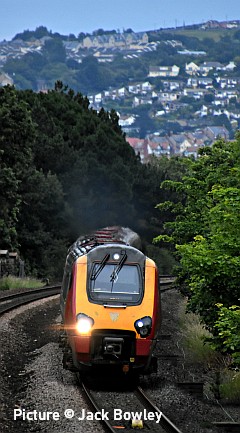
Forthcoming events
(see also our Calendar page for venues)
Note: we have removed all entries up to the end of August as the events are cancelled. The Railway Touring Company North Wales trains in July are no longer being advertised.
September 2020
Saturday 5 September Steam at Chester 'The Cheshireman' (Railway Touring Company). Norwich to Chester. Loco 6233 for part of the journey.
43 013 Mark Carne CBE and 43 062 John Armitt working 1Q30 Derby RTC to Derby RTC New Measurement Train passing through Llandudno Junction , 16 July. Picture by Ryan Lloyd.
Another extra issue will appear on Friday morning 24 July: thanks to for all who have sent contributions. - Charlie
Class 230 news
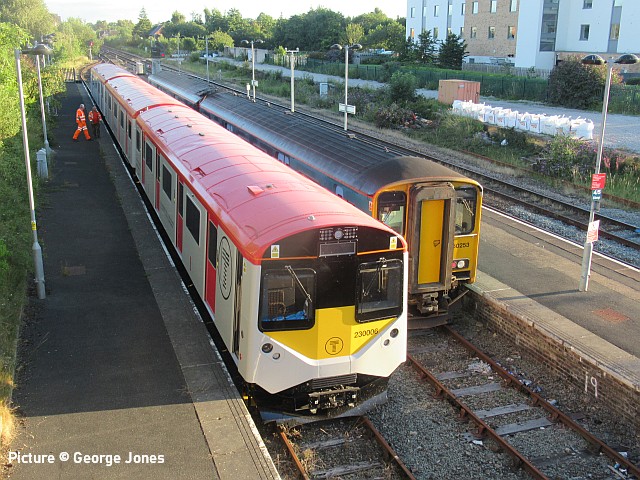
On 20 July 230 006, the first of Transport for Wales's five rebuilt London Underground units, made its way from the Vivarail company's base at Long Marston to Wrexham General station, where it will stable overnight in the bay platforms, as the units will do when they enter service. (picture above by George Jones). On 21 July at 10:30 it will (all being well) proceed along the Borderlands line to Bidston and on to Merseyrail's Birkenhead North depot, arriving at 12:02.
Looking back: Wrexham area - by David Pool
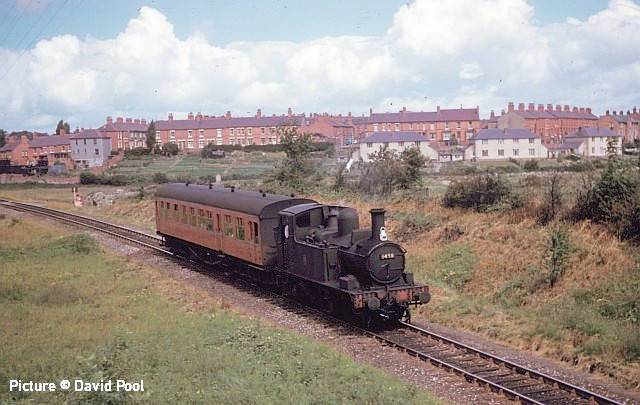
The line between Wrexham and Ellesmere was closed to passengers in 1962, before the Beeching Report led to massive further closures. On 15 July 1960 a Collett 0-4-2T No. 1458 with an Autocoach was working the 1105 Wrexham Central to Ellesmere, photographed approaching Hightown Halt on the outskirts of Wrexham.
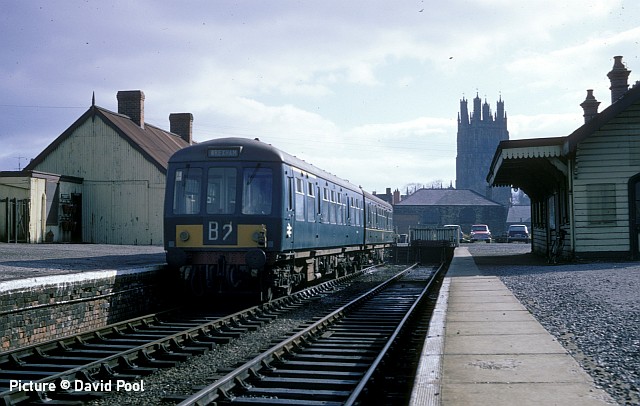
Wrexham Central station has had many changes over the years. The Cambrian Railways line from Ellesmere originally shared the station with the Great Central line from Seacombe and Chester Northgate. On 4 March 1967 a Class 108 DMU M51568 / M50931, comprising one blue and one green coach, has arrived on the 10:35 from Chester. I think this would have been from Northgate, but would appreciate confirmation of this. The freight line towards Ellesmere would be out of sight on the right of the image. In the 1970s these platforms were closed, and trains from Bidston terminated at a platform on what had been the freight line to Ellesmere. Finally, a new terminus was opened about 400 metres West towards Wrexham Exchange, on what was by then a single line, and is the Wrexham Central station of today.
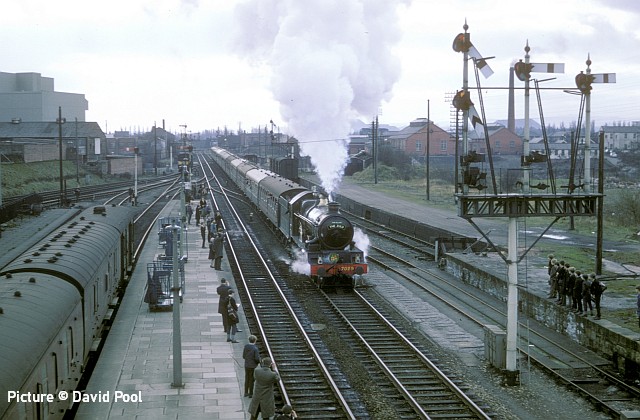
My visit to Wrexham on 4 March 1967 was primarily to photograph the two special steam workings which marked the end of steam between Birkenhead Woodside and Paddington, “The Birkenhead Flyer” and “The Zulu”, which were featured in the Notice Board earlier this year. 7029 Clun Castle was on the Northbound “Zulu”, and is accelerating away from a check at Croes Newydd, watched by an appreciative audience at Wrexham General station.
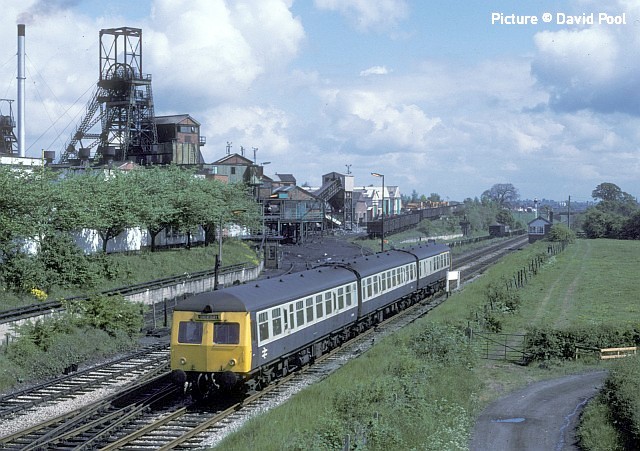
Bersham Colliery was unusual, in that the buildings were alongside the main line, making ai interesting background to photographs. A Class 120 dmu M50668 / M59262 / M50721 is working the 10:30 Chester to Shrewsbury on 29 May 1980.
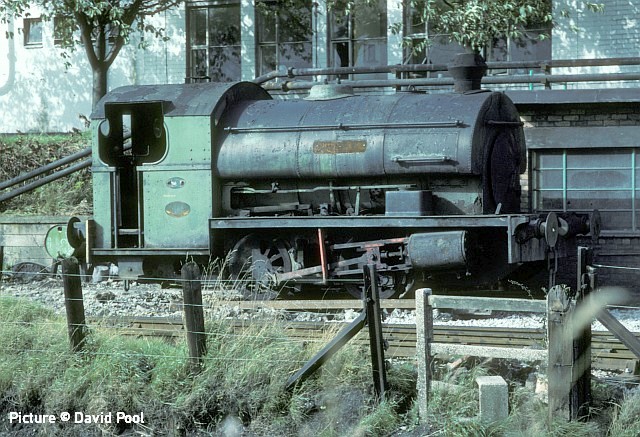
A year later on 9 October 1981 at the same location, a Peckett No. 1935 Hornet was at the end of the Bersham exchange sidings. This locomotive had been built in 1937 for the Black Park Colliery in Shropshire, where the limited clearances required that cab height be reduced, as also was a replacement chimney which appeared to have been based on an American smokestack! Hornet is now in the museum of the Ribble Steam Railway, and hopefully may someday be steamed again.
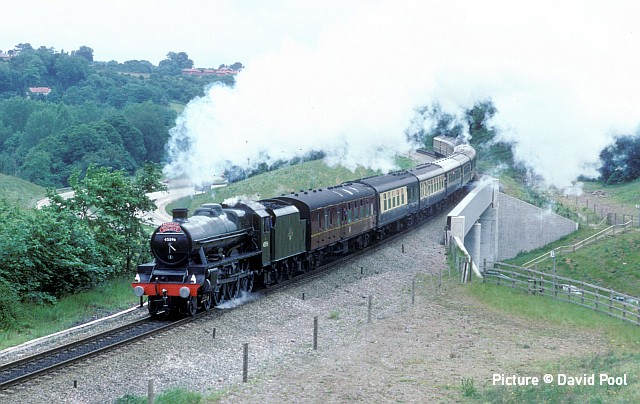
This might be seen as just another photo of a Steam Special, but the location is not often featured. When the double track between Wrexham and Saltney junction was singled, a new bridge was needed to cross the A483 dual carriageway at Gresford. In order to minimise the cost, the bridge was designed to carry only a single track. Subsequently, the need to increase the capacity of the line has led to the single track being doubled between Saltney Junction and Rossett, leaving the single line through Gresford and over the A483 as the remaining limitation on capacity, with the cost of a new bridge being the main obstacle to further improvements. The Jubilee 45596 Bahamas is on a Welsh Marches Express on 15 June 1991, having come on the train at Crewe. One report suggested it was going to Newport, but I have not been able to confirm this.
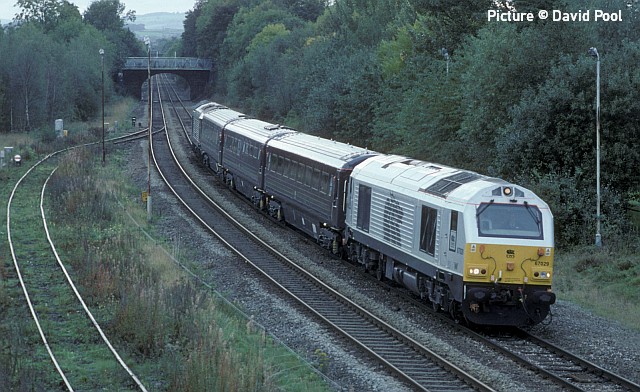
On 11 October 2006 a special train was run to evaluate the feasibility of a service between London Marylebone and Wrexham. The 10:16 from Marylebone comprised 67 029 Royal Diamond with the EWS Management Coaches and “Royal” 67 006 Royal Sovereign on the rear, here approaching Croes Newydd. The conclusion was favourable, and the Wrexham and Shropshire Railway introduced the service in April 2008. Although it was reliable and well liked, the journey time was significantly longer than for other routes to London, and following other problems relating to access and profitability, the service ended in 2011, the locomotives and stock being used for the Chiltern Railways services.
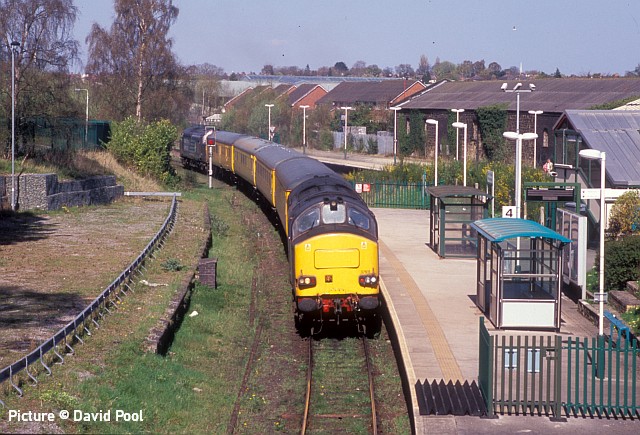
The single line from Wrexham Exchange platform to Wrexham Central now rarely sees any locomotives, so the visit of a Network Rail Test Train on 15 April 2014 was most unusual. These trains frequently visit the Bidston to Wrexham line, but normally go directly into Wrexham General station and the Croes Newydd reversing siding or onwards to Shrewsbury. After reversing at the Central station the train reversed again at Wrexham Exchange Junction to get to Wrexham General station and Croes Newydd. DRS locomotive 37 611 is hauling Network Rail coaches 9523, 77997, 72630 and 99966, with 37 612 on the rear.
Current scenes
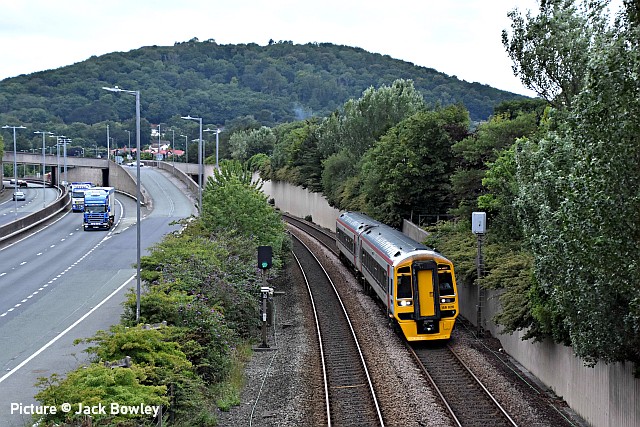
158 826 on 1D70 Llandudno Junction to Chester appraching Colwyn Bay, 13 July (Jack Bowley).
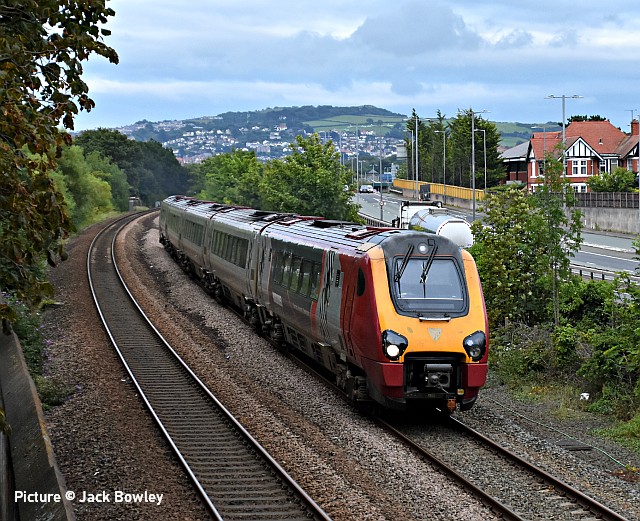
221 115 in its Bombardier wrap works 1D90 Crewe to Holyhead on 13 July, seen at West End footbridge, Colwyn Bay (Jack Bowley).
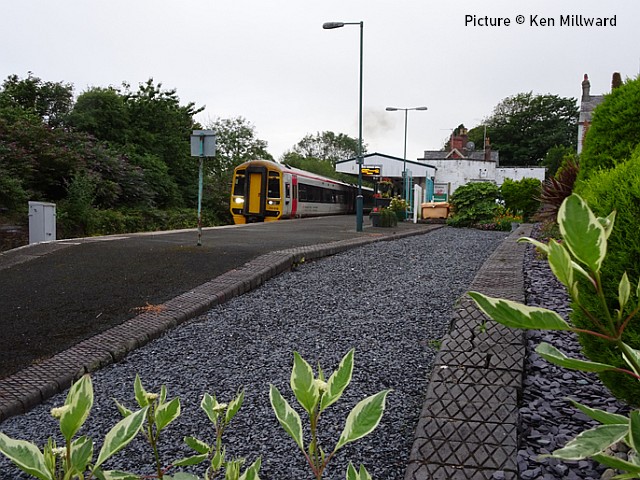
Criccieth station on 13 July, with 158 818 on the 20:26 from Pwllheli to Machynlleth. Picture by Ken Millward who notes: 'There was not a single soul on board.'
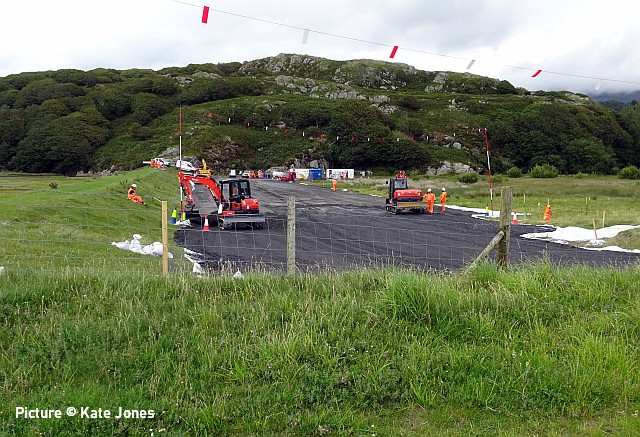
Kate Jones writes: 'The preparation for the start of the Barmouth viaduct repairs is under way. The picture is of the base going down for the compound at the Arthog side of the bridge; there was a metal grid and a liner laid down on the boggy ground before the ballast. It makes sense for them to make a good compound when you consider the time for the repairs is over three years.'
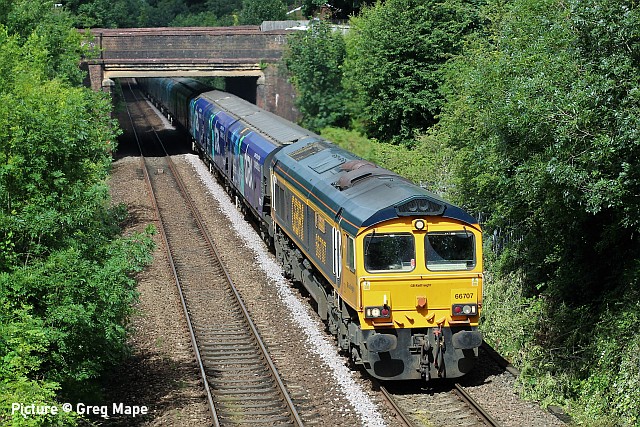
On 6 July, 66 707 Sir Sam Fay passing the site of Baguley station with a Liverpool - Drax Biomass train.
Following the the Roman Nose, 1998 - remembered by Barrie Hughes
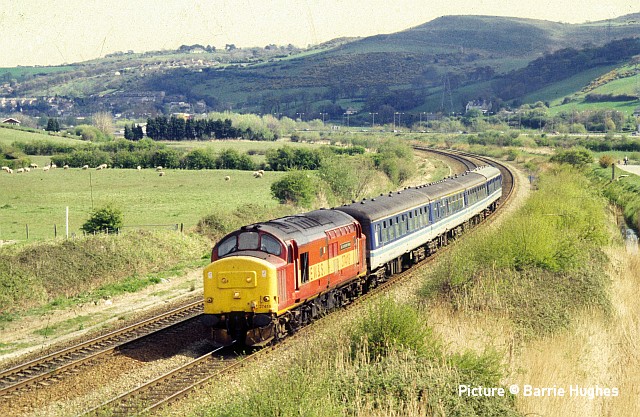
Seen whilst waiting for Hertfordshire Rail Tours 'The Roman Nose' to appear on 18 April 1998, 37 418 in EWS livery named East Lancashire Railway hauled a typical 1D65 10:18 Crewe-Holyhead 4-coach Regional Railways set of coaches, approaching Llandudno Junction from the then-new A470 bridge. This loco's return working was to Stockport. 37 418 proved to be a great survivor and wasl in use on Cardiff - Rhymney services in March 2020, albeit with nameplate having been removed in 2005.
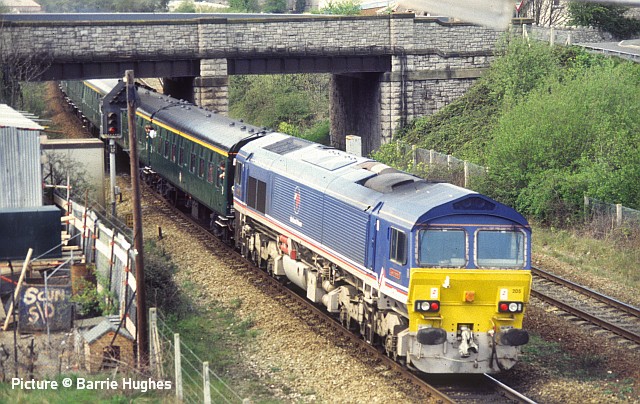
Two Class 37s (37 377/098) were on the front of HRT's green-livery Mk1s from Crewe and National Power's 59 205 on the rear so it could be on the front up the Conwy Valley. The loco had been named L Keith McNair a month previously having lost its Vale of Evesham nameplate it had carried for the previous two years. This loco is today in DB Cargo cherry red livery and used on Mendip stone trains having been based at National Power's Ferrybridge Power Station depot previously.
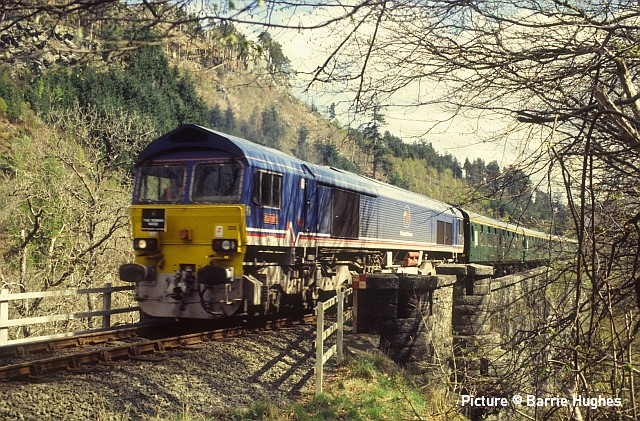
A scrabble along muddy forestry tracks provided this unusual view of Gethin's Bridge with 59 205 leading up the Lledr Valley. The loco could be heard on the steep gradient from miles away ... or perhaps it was the two 37s banking? Several times the 59 seemed to be struggling with the gradient and the two 37s were required to help.
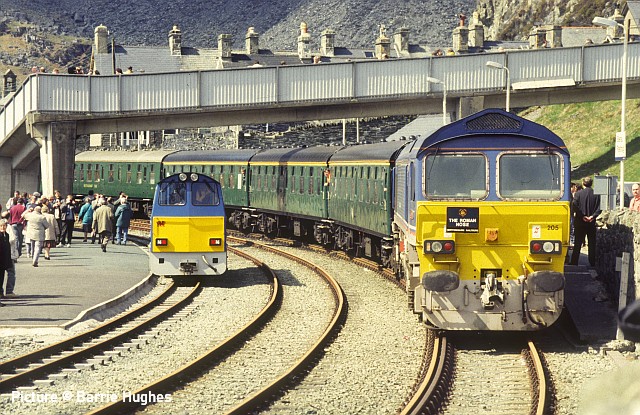
Catching up with the train at Blaenau Ffestiniog, the Ffestiniog Railway's recently released diesel Vale of Ffestiniog was posed in the rarely used second narrow gauge platform face at Blaenau Ffestiniog station so that the two locos in identical livery could be compared side by side.
In fact the FR's version more closely resembles a Class 58 than a Class 59 having a narrow body between the wider cabs at each end. It has since been turned out in a two tone green livery. This platform face may come into its own if the FR's plan for a 'Dinas shuttle' ever comes about to the foot of the incline by the Ffestiniog Power station. A hydrogen-powered loco has been discussed for this service, and the trackbed was being cleared immediately prior to the pandemic lockdown. (See Daily Post article, January 2020.)
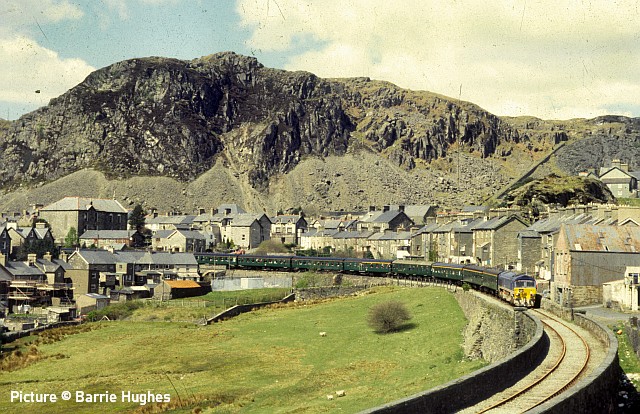
59 205 inches along the curvaceous former narrow-gauge track approaching the viaduct between Blaenau and Manod.
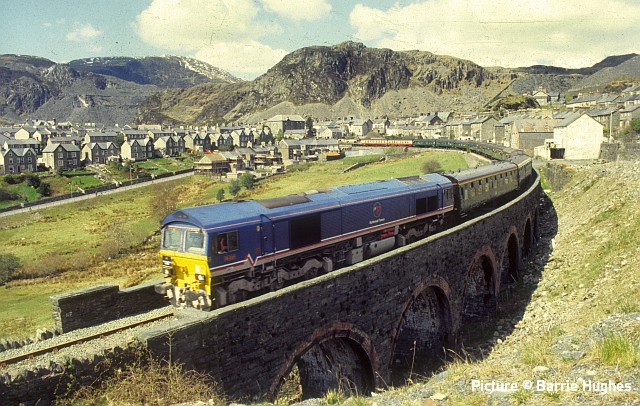
Approaching Manod.
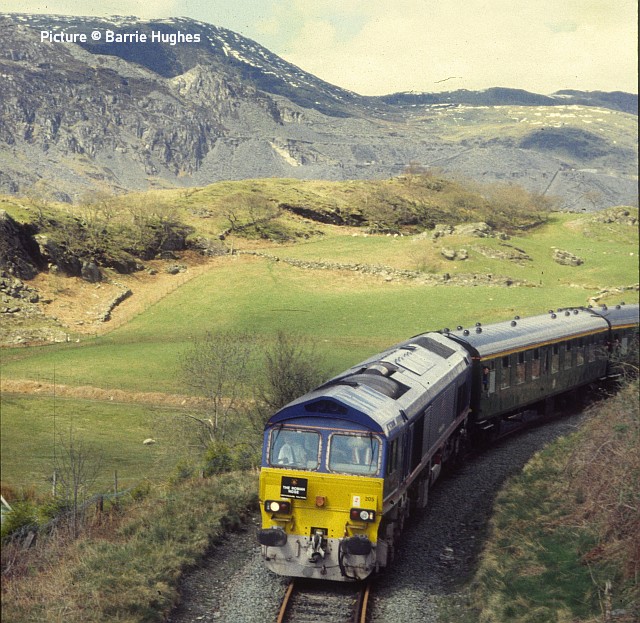
59 205 caused a lot of squealing of flanges as the reverse curves on this line abound with check-rails as seen from the A470 overbridge at Manod with Easter snow still lingering on the mountain tops from a week earlier.

The train had to slow down to a crawl because of a sheep and two lambs as it approached Ffestiniog.
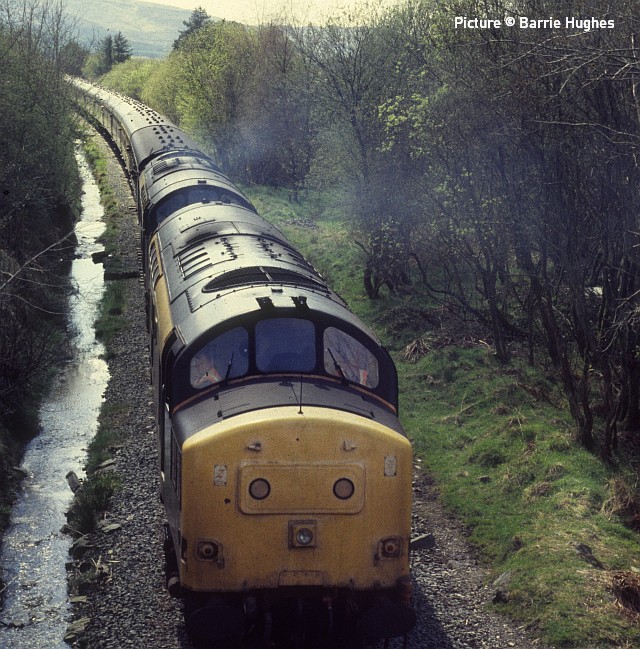
37 377 and 37 098, both in Engineers ‘Dutch’ livery on the rear as the 'Roman Nose' slowly grinds its way over rusty rails past frozen streams into the former Llan Ffestiniog station.
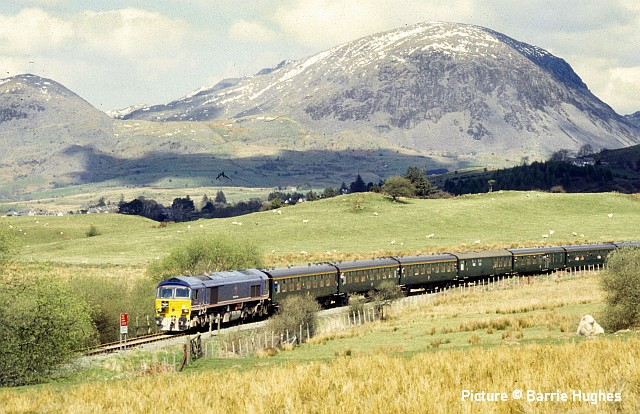
Approaching Cynfal with a snow-clad Manod Mawr in the background.
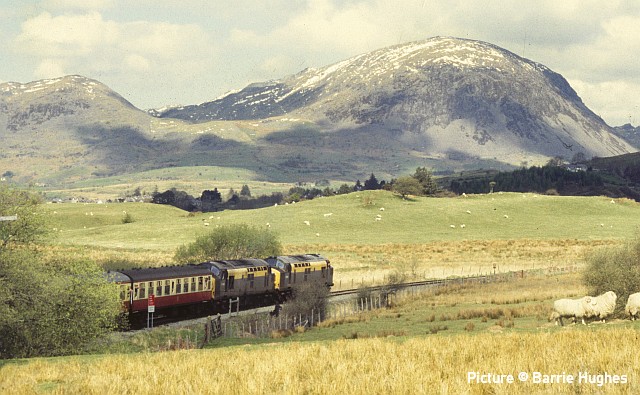
The 37s on the rear of the Roman nose near journey’s end at Cynfal, seen from the A470 layby. The train then made its way to the Trawsfynydd Nuclear Power Station waste transfer siding 1.5 miles further on.
The section of the line beyond Llan Ffestiniog was built by the GWR and so is much less curvaceous than the former narrow gauge section between there and Blaenau Ffestiniog. The route east of Trawsfynydd towards Bala was closed in 1961 and lifted when Tryweryn reservoir was built across the trackbed. A preservation group is still trying to reopen the Trawsfynydd Power station to Blaenau Ffestiniog section which NR has disconnected but left intact in case of future need of freight traffic, much like the Amlwch branch. Negotiations continue with NR about getting an access licence. I regret never taking advantage of Sunday shuttles or railtours to travel on this scenic branch.
For another report, see Dave Sallery's website.
More 'Growlers' - from Dave Sallery's archive
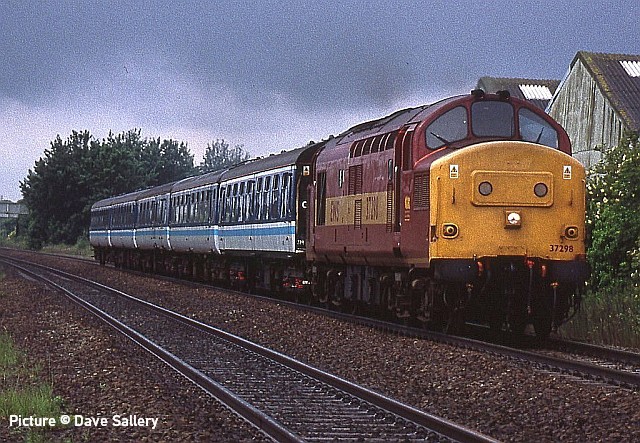
Substituting for an unavailable 37/4, 37 298 seen near Prestatyn on 12 June 99. On 25 August 1999 this loco joined the batch of 37s dispatched to France for use in high-speed line construction. It returned in October 2000, but never worked again before being scrapped in 2006.

37 413 Loch Eil Outward Bound in the short-lived Transrail livery, passes Calveley on the Chester- Crewe line, 8 May 1996. In 1997 it was re-named The Scottish Railway Preservation Society. It was withdrawn after a serious failure in 2000; the name was later transferred to 37 411. 413 was sold to a preservation group, and seems to have had a number of owners, including DRS who didn't run it, before being scapped in 2017.
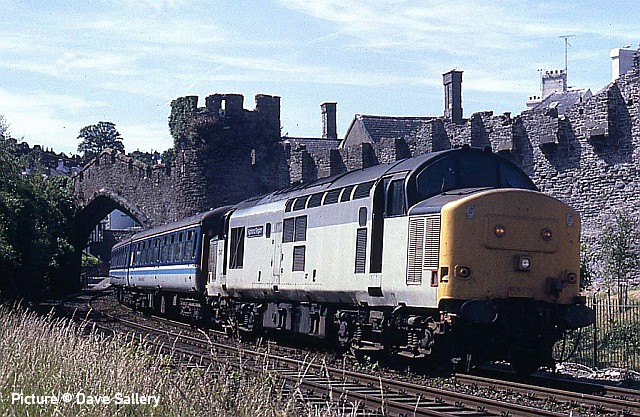
37 417 Highland Region, another one that was bought by DRS and later scrapped, passes through the town walls at Conwy on 27 June 95.
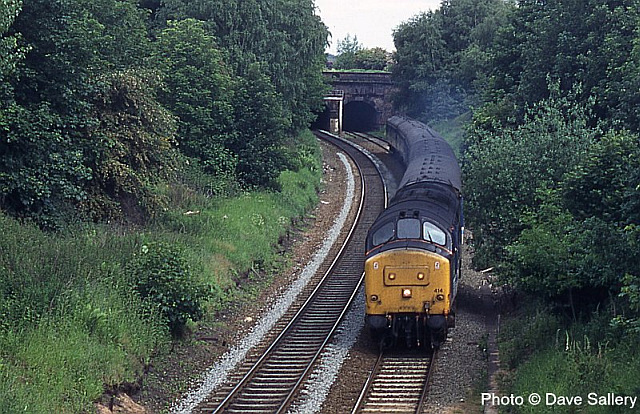
On 13 June 1996 37 414 Cathays C&W Works emerges from Christleton Tunnel, a structure which will be a problem if the line is ever electrified. The area is notorious for flooding, and a canal passes above. 37 414 was one of the first to be allocated to North Wales duties; it was withdrawn in 2000 and sold to a short-lived enerprise 'BRE Ltd' who moved it to the Weardale Railway, but it had already been 'stripped' or component by then and was eventually scrapped.
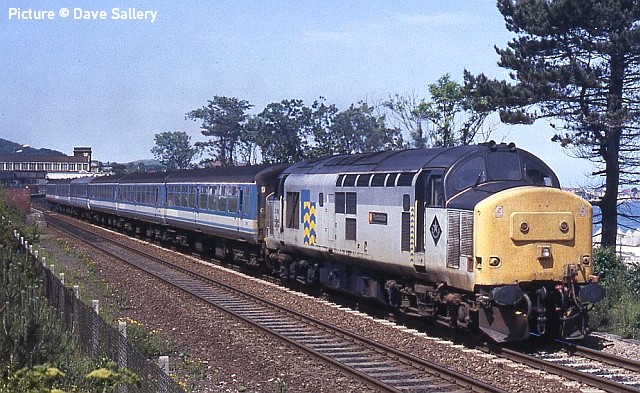
The only one of these five 37s to survive to the present is 37 418, which was photographed on 5 June 1993 departing from Colwyn Bay, still in its 'Railfreight Petroleum' colours as Pectinidae. Six-coach trains were found on some workings in the early days of the 37 era. After withdrawal it worked on the East Lancashire Railway for a while before being hired by Colas who it on the Cardiff - Rhymney service. Loco-hauled working has now ceased, so it may re-appear on Network Rail workings.
On Wirral Lines - pictures by Trefor Thompson
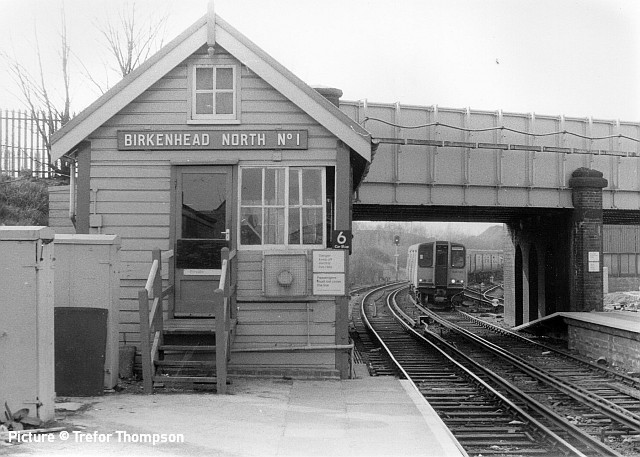
A few images recalling the days when the Wirral lines were all operated by manual signalling : all taken on 18 April 1985. Above: Up train approaching Birkenhead North station.
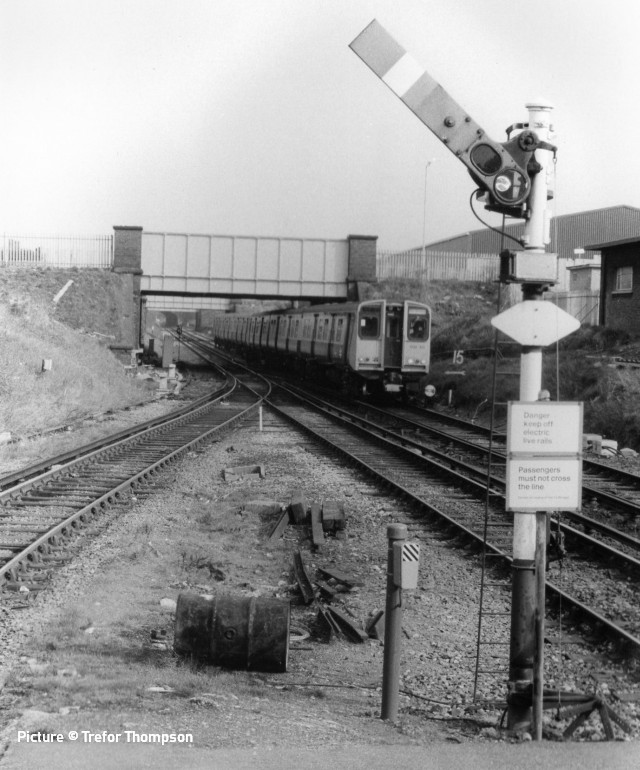
Down train approaching Birkenhead North station. Today the long-lived 507 and 508 units are in their last days, soon to be replaced by new stock.
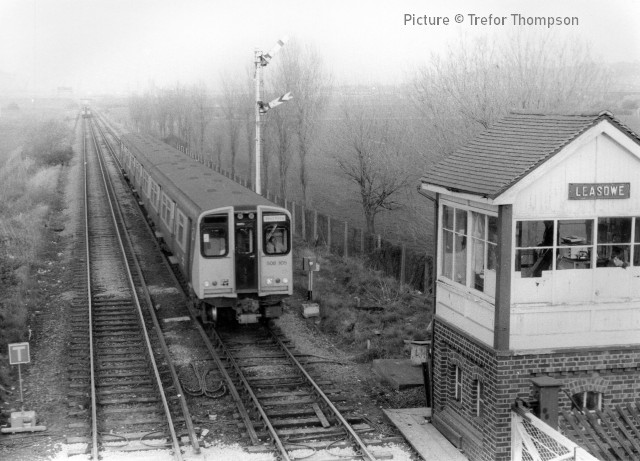
Down West Kirby train approaching Leasowe.
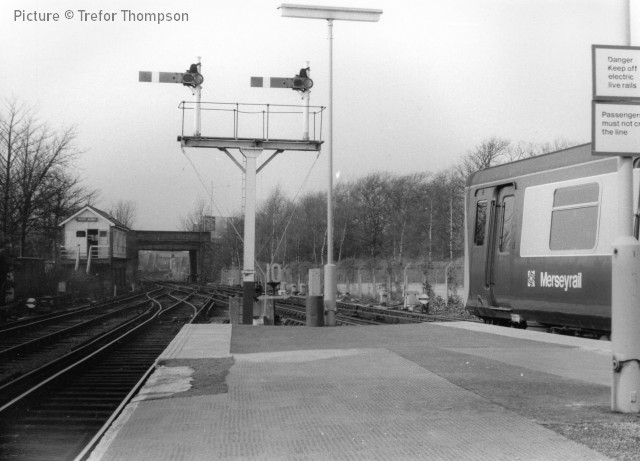
West Kirby.
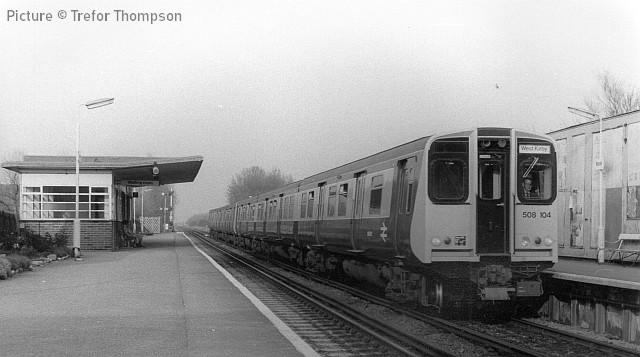
Down train at Meols; the former Wirral Railway stations,when taken over by the LMS, gained some the rare examples of the LMS's own 'art deco' style of station building.
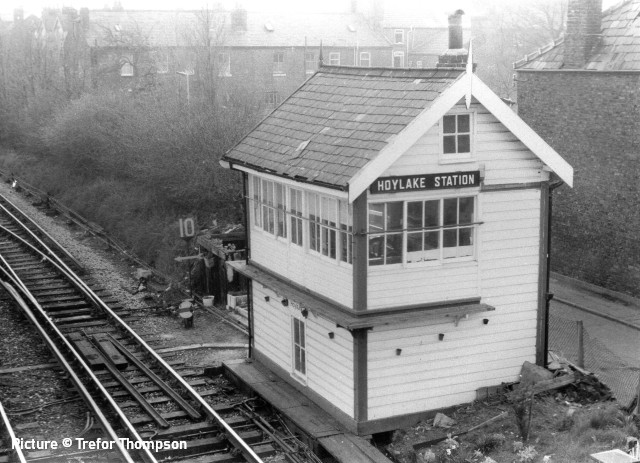
Hoylake Station signal box
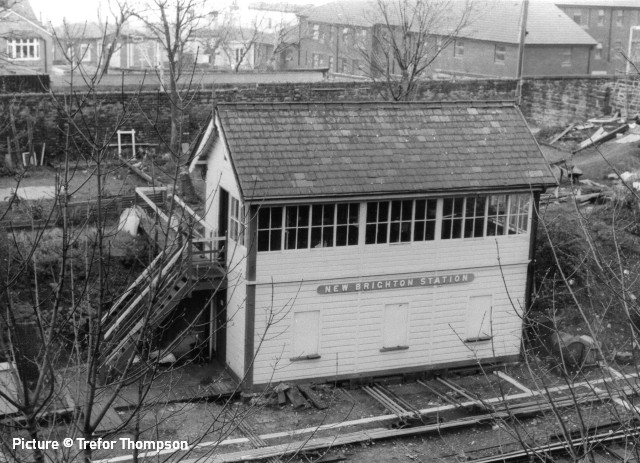
New Brighton signal box.
North Wales Coast home page | Archive | Previous Notice Board